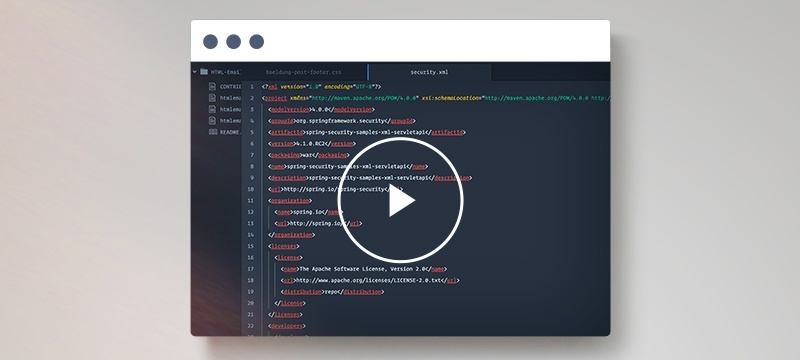1. Overview
A common requirement for a web application is to redirect different types of users to different pages after login. An example of this would be redirecting standard users to a /homepage.html page and admin users to a /console.html page for example.
This article will show how to quickly and safely implement this mechanism using Spring Security. The article is also building on top of the Spring MVC tutorial which deals with setting up the core MVC stuff necessary for the project.
2. The Spring Security Configuration
Spring Security provides a component that has the direct responsibility of deciding what to do after a successful authentication – the AuthenticationSuccessHandler.
2.1. Basic Configuration
Let’s first configure a basic @Configuration and @Service class:
@Configuration
@EnableWebSecurity
public class SecSecurityConfig {
@Bean
public SecurityFilterChain filterChain(HttpSecurity http) throws Exception {
http
.authorizeRequests()
// ... endpoints
.formLogin(formLogin -> formLogin.loginPage("/login.html")
.loginProcessingUrl("/login")
.defaultSuccessUrl("/homepage.html", true))
// ... other configuration
return http.build();
}
}
The part of this configuration to focus on is the defaultSuccessUrl() method. After a successful login, any user will be redirected to homepage.html.
Furthermore, we need to configure users and their roles. For the purpose of this article, we’ll implement a simple UserDetailService with two users, each having one single role. For more on this topic, read our article Spring Security – Roles and Privileges.
@Service
public class MyUserDetailsService implements UserDetailsService {
private Map<String, User> roles = new HashMap<>();
@PostConstruct
public void init() {
roles.put("admin2", new User("admin", "{noop}admin1", getAuthority("ROLE_ADMIN")));
roles.put("user2", new User("user", "{noop}user1", getAuthority("ROLE_USER")));
}
@Override
public UserDetails loadUserByUsername(String username) {
return roles.get(username);
}
private List<GrantedAuthority> getAuthority(String role) {
return Collections.singletonList(new SimpleGrantedAuthority(role));
}
}
Also note that in this simple example, we won’t use a password encoder, therefore the passwords are prefixed with {noop}.
2.2. Adding the Custom Success Handler
We now have two users with the two different roles: user and admin. After a successful login, both will be redirected to hompeage.html. Let’s look at how we can have a different redirect based on the user’s role.
First, we need to define a custom success handler as a bean:
@Bean
public AuthenticationSuccessHandler myAuthenticationSuccessHandler(){
return new MySimpleUrlAuthenticationSuccessHandler();
}
And then replace the defaultSuccessUrl call with the successHandler method, which accepts our custom success handler as a parameter:
@Bean
public SecurityFilterChain filterChain(HttpSecurity http) throws Exception {
http
.authorizeRequests()
// endpoints
.formLogin(formLogin -> formLogin.loginPage("/login.html")
.loginProcessingUrl("/login")
.successHandler(myAuthenticationSuccessHandler())
// other configuration
return http.build();
}
2.3. XML Configuration
Before looking at the implementation of our custom success handler, let’s also look at the equivalent XML configuration:
<http use-expressions="true" >
<!-- other configuration -->
<form-login login-page='/login.html'
authentication-failure-url="/login.html?error=true"
authentication-success-handler-ref="myAuthenticationSuccessHandler"/>
<logout/>
</http>
<beans:bean id="myAuthenticationSuccessHandler"
class="com.baeldung.security.MySimpleUrlAuthenticationSuccessHandler" />
<authentication-manager>
<authentication-provider>
<user-service>
<user name="user1" password="{noop}user1Pass" authorities="ROLE_USER" />
<user name="admin1" password="{noop}admin1Pass" authorities="ROLE_ADMIN" />
</user-service>
</authentication-provider>
</authentication-manager>
3. The Custom Authentication Success Handler
Besides the AuthenticationSuccessHandler interface, Spring also provides a sensible default for this strategy component – the AbstractAuthenticationTargetUrlRequestHandler and a simple implementation – the SimpleUrlAuthenticationSuccessHandler. Typically these implementations will determine the URL after login and perform a redirect to that URL.
While somewhat flexible, the mechanism to determine this target URL does not allow the determination to be done programmatically – so we’re going to implement the interface and provide a custom implementation of the success handler. This implementation is going to determine the URL to redirect the user to after login based on the role of the user.
First of all, we need to override the onAuthenticationSuccess method:
public class MySimpleUrlAuthenticationSuccessHandler
implements AuthenticationSuccessHandler {
protected Log logger = LogFactory.getLog(this.getClass());
private RedirectStrategy redirectStrategy = new DefaultRedirectStrategy();
@Override
public void onAuthenticationSuccess(HttpServletRequest request,
HttpServletResponse response, Authentication authentication)
throws IOException {
handle(request, response, authentication);
clearAuthenticationAttributes(request);
}
Our customized method calls two helper methods:
protected void handle(
HttpServletRequest request,
HttpServletResponse response,
Authentication authentication
) throws IOException {
String targetUrl = determineTargetUrl(authentication);
if (response.isCommitted()) {
logger.debug(
"Response has already been committed. Unable to redirect to "
+ targetUrl);
return;
}
redirectStrategy.sendRedirect(request, response, targetUrl);
}
Where the following method does the actual work and maps the user to the target URL:
protected String determineTargetUrl(final Authentication authentication) {
Map<String, String> roleTargetUrlMap = new HashMap<>();
roleTargetUrlMap.put("ROLE_USER", "/homepage.html");
roleTargetUrlMap.put("ROLE_ADMIN", "/console.html");
final Collection<? extends GrantedAuthority> authorities = authentication.getAuthorities();
for (final GrantedAuthority grantedAuthority : authorities) {
String authorityName = grantedAuthority.getAuthority();
if(roleTargetUrlMap.containsKey(authorityName)) {
return roleTargetUrlMap.get(authorityName);
}
}
throw new IllegalStateException();
}
Note that this method will return the mapped URL for the first role the user has. So if a user has multiple roles, the mapped URL will be the one that matches the first role given in the authorities collection.
protected void clearAuthenticationAttributes(HttpServletRequest request) {
HttpSession session = request.getSession(false);
if (session == null) {
return;
}
session.removeAttribute(WebAttributes.AUTHENTICATION_EXCEPTION);
}
The determineTargetUrl – which is the core of the strategy – simply looks at the type of user (determined by the authority) and picks the target URL based on this role.
So, an admin user – determined by the ROLE_ADMIN authority – will be redirected to the console page after login, while the standard user – as determined by ROLE_USER – will be redirected to the homepage.
4. Conclusion
As always, the code presented in this article is available over on GitHub. This is a Maven-based project, so it should be easy to import and run as it is.





